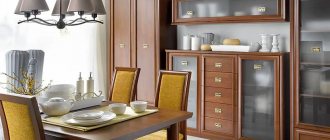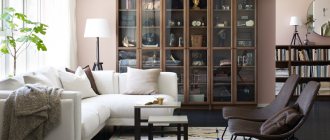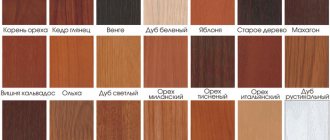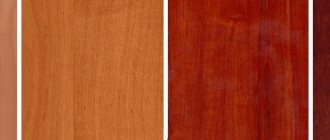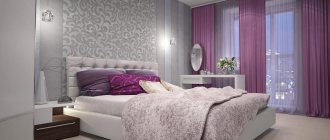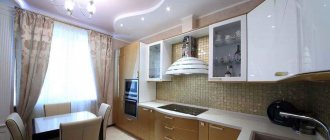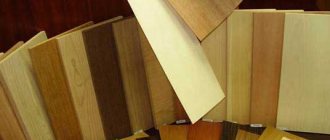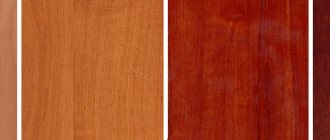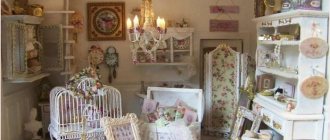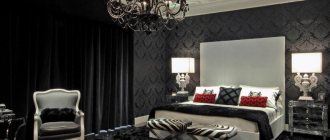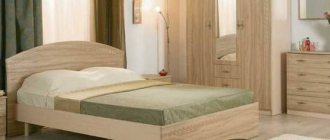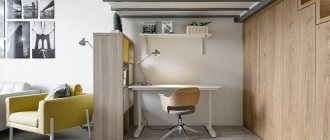Nut
The most popular, most often dark brown color with a heterogeneous pattern. Sometimes the nut may have a reddish tint or be greenish-gray. The texture also changes - from sinuous stripes to dots and strokes.
Instagram @kyhni67_milan
Wenge
Such a surface can be blue-black, with a purple tint, chocolate with golden veins, or burgundy. Living wood has a richer palette than laminated material, but costs more. Wenge, like walnut, dominates the interior due to its richness. Therefore, the main background should be neutral or with small bright splashes.
Instagram @wood_life_studio
Instagram @pinskdrevru
Red tree
Mahogany, padauk, sandalwood, berry yew - all species have a red-brown cut with varying degrees of richness and texture. If it is wood and not imitation, the surface will darken over time.
Instagram @belorawood
Pixabay
Ebony
A common name for several breeds. Natural material or lamination with this effect can be dark brown, black, reddish, with beige stripes.
Instagram @sergey_sudarev_33
Instagram @infogradient
Next we will show another palette of chipboard colors for furniture with names and photos.
Light
The light color scheme includes not only white furniture, but also many options with a wooden structure.
Light ash
One of the most popular shades in furniture company catalogs. The second name is shimo ash. The color looks like coffee heavily diluted with milk. Depending on what you have in front of you - furniture made of natural wood or chipboard - the undertones can vary from gray to pink or even blue.
The main advantage of cool color is lightness and neutrality. Even large pieces of furniture will not look bulky.
Oak
There is perhaps no more diverse wood than oak: it can be not only light, but also neutral or dark in color. The colors of solid wood vary even within the same category:
- Lactic. Light beige shade with a pinkish undertone. Warm pastel colors are suitable for both individual furniture elements and entire sets.
- Bleached. It has a more pronounced texture, the shade goes gray, sometimes even blue. There is also a richer creamy tone.
See what the Sonoma oak color looks like in the interior.
Light beech
The wood is golden in tone, almost uniform in texture with small brown inclusions. When choosing cabinet furniture in a light beech shade, rely on simple, minimalist forms: such products have a better chance of fitting harmoniously into a modern interior.
Karelian birch
One of the most unusual colors of natural wood: thanks to the sinuous fibers and heterogeneous inclusions, the texture resembles marble. The shade is warm, yellowish.
Expensive furniture sets, chests of drawers, sideboards, and sideboards are made from natural solid Karelian birch. Even a small product in this tree will become an accent in the interior.
Alder
A classic representative of the orange wood that was popular in the early 2000s. Today, red wood is practically not used due to the visual “cheapness” of the shade. However, if you sincerely like reddish shades and are going to order furniture made of natural alder or in a film of this color, choose models with chamfers, paneling, milling and other decor.
Be sure to check out 10 reasons why your interior may look cheap.
Maple
One of the most successful light colors of furniture is maple. The noble light shade looks amazing in both minimalist, classic and even industrial interiors! Natural maple is neutral, mandala goes orange, champagne goes into a cool pale pink.
Pine
The yellowness of natural pine causes controversial feelings: on the one hand, it looks inexpensive. On the other hand, it is quite appropriate and aesthetically pleasing in eco-interiors. If you don’t like the yellow undertone, you can choose more noble shades: aland (peach undertone), cascina (gray-beige), loft (gray-white).
Imitation
Manufacturers offer the most daring and non-standard furniture collections with original facade surfaces that imitate the texture of precious wood, leather or marble. A successful combination of furniture colors allows you to create unique modern or classic interiors. To create a harmonious and holistic space, it is necessary that the pieces of furniture are combined not only with each other, but also with the decorative decoration of the walls, floor or ceiling.
A special table has been developed for combining furniture color with wall decor:
- gray walls are in harmony with red, orange, blue or brown furniture;
- the pink background of the walls is successfully emphasized by decorative elements painted in deep blue, gray, light blue or white;
- Green walls blend organically with furniture in yellow, bluish, orange and grayish shades.
Color selection is the most important task; it must be solved at the initial stages of repair. It is necessary to take into account the combination of individual pieces of cabinet furniture with each other and with the finishing, to provide for the influence of color on the perception of the room and the emotional state of a person.
Neutral
If too light or dark shades of facades do not suit you, pay attention to mid-tones. Their main advantage is their versatility: they fit any room style, size, or functional purpose.
Pear
Pear wood is darker than alder, but lighter than apple tree: at the same time, it retains the red color characteristic of both types of wood. The texture is large, but not too pronounced (the exception is Tirano pear). Suitable for furniture with milling or smooth fronts.
Beech
The color palette of beech wood includes light colors - for example, artisan. But most often the middle ones are used: Bavaria, Westphalian, country, Landmark, natural. The tone of the furniture is mostly warm and golden. Often used as a quality alternative to wood that is too light.
Read about how to choose a wood-look kitchen set.
Cherry
Cherry wood varies in tone, saturation, and brightness of the pattern. For example, red Calvados or medium oxford have an almost imperceptible texture, while orange Locarno, on the contrary, has noticeable fibers. Riverside cherry has pink streaks on its surface.
How to combine wood in the interior
In any interior you can find many wooden components. This is not only a cabinet or table, but also flooring (laminate or parquet), a door, a mirror frame. To create a harmonious interior, you should focus not only on the colors of the furniture and their names, but also on the color of the surroundings; The following tips will help:
- When choosing the color of furniture, it is important to consider what kind of interior it is intended for. There are interiors (usually modern) where the accent is important, and its role can be played not only by the closet or doors, but also by the floor covering. In classic interiors, coherence and color harmony are more important.
In the office Source static.wixstatic.com
- Accent. In most interiors, the emphasis is on furniture, with the floor and walls serving as the background. Therefore, it is important that there is a contrast in color between the set and the decoration. In this case, doors and baseboards should match, but doors and floors should not.
- Limitation. It is recommended to limit yourself to two shades of wood in one room to avoid chaos. Three colors are allowed if one of them is white.
On a white background Source st.hzcdn.com
- Combination. There will always be a good result if you combine only warm or only cold tones of wood.
- The shades should not be related, differing by a tone or two - you will always get the impression that you tried to choose a color, and it didn’t work out.
- Unity of texture (pattern). If the surface of the floor or doors has a noticeable ring pattern, furniture, regardless of color, is also chosen with a bright texture. Textiles are chosen using the same principle - colors may differ, but the print must be repeated.
Unity of texture Source veloxng.com
- Unity of finishing style. Harmony will be preserved if all wooden surfaces, regardless of color and species, are processed in the same way: deliberately rough or, conversely, carefully polished.
- Separation. There are two equally disastrous situations: when, for example, the table merges with the floor covering, or when they do not combine in any way. In both cases, a carpet can save the situation. It will separate the table from the floor, creating a distracting color accent.
In the hallway Source dekormyhome.ru
Recommendations for color combinations
A combination of wooden textures is possible with other wood or plain surfaces. For example, milky oak, maple, or a regular beige matte façade would be suitable for wenge.
For neutral oak, beech or pine, choose something colored: green, blue.
Too active colors, like mahogany or cherry, need a neutral base: wallpaper without a pattern, light upholstery, textiles.
Walnut, birch, alder, ash will create an excellent duo with glossy facades in white or black. Against the background of shine, the tree will sparkle in a new way.
If you are choosing a kitchen, be sure to research which is better - glossy or matte.
Wood is a universal material. It creates a unique coziness at home, does not go out of fashion, and looks appropriate in any style, in any room. Choose the shade you like and be sure to use it in your interior!
Living room decoration
Wood in the living room interior always looks very impressive and is appropriate in almost any design. If this is a Scandinavian style, then the use of light woods emphasizes the connection with nature; wooden furniture in pastel shades is suitable for Provence. Small and simple wooden details are appropriate in minimalism and hi-tech.
Stumps and large saw cuts in the interior of the living room can play the role of a coffee table and become the main focus of attention of guests. You can make an accent wall near the TV from saw cuts and pebbles; from processed sticks and branches you can make a cornice, lamp and other accessories.
How to choose and buy solid birch furniture that will last a long time
1. Analyze quality indicators.
The quality of furniture is influenced not only by the material used, but also by production and assembly technologies. Let's look at the main parameters: the connection of parts and the strength of the product.
- Connecting parts.
- Strength.
Various types of joints have been developed, but, as a rule, these places are additionally strengthened by gluing. Therefore, it is necessary to carefully inspect all joints to identify traces of glue.
In pursuit of savings, the manufacturer can fasten furniture parts only with the help of metal staples; in the future they will become loose and rust, and the furniture will quickly fail. According to the technology, the master temporarily connects the parts with such staples to allow the glue to dry.
You can verify the strength of the product in a simple way - press it in several places. If pressing is accompanied by characteristic creaks, then, most likely, the furniture is not reliable and durable enough. If you are planning to purchase a table or a set of chairs made of solid wood, try lightly “beating” the legs and swaying them from side to side. A quality product will stand firmly and without sound.
2. Check the quality of processing.
The complete finishing process consists of sanding, painting and polishing. Insufficient quality performance of any operation will certainly affect the final result.
- Grinding stage.
- Coloring.
- Polishing.
During this operation, it is very important to remove all rough irregularities, chips and small scratches, since subsequent stages of painting and polishing will not be able to smooth out these defects, and they will spoil the impression.
You can identify unevenness and grinding errors by looking at the surface of the product from different angles to see the reflection of light. Grainy areas, spots and dark spots indicate poor surface grinding.
Using staining, you can effectively imitate elite wood species or emphasize the natural beauty of birch. The paint must be applied evenly, without leaving sagging or unpainted areas. Parts of one item must have the same color. Sometimes furniture is artificially aged. For example, in order for a network of cracks to be visible in some places of the product, special techniques are used - the parts are locally heated over a hot stove.
Polishing brings the surface of solid wood furniture to perfect smoothness. The surface feels evenly polished, there are no internal bubbles or dust particles. Run your hand over the surface and make sure it is smooth and level.
It’s a shame when wood furniture is not made of very high quality and has the following disadvantages: rough finish, excessive gloss or cloudiness that hides the beautiful texture, scratches, internal bubbles, dents.
Before placing an order for the manufacture of solid birch furniture from a manufacturer, make sure that this company employs specialists with a good reputation. Manufactured items should be carefully inspected to ensure proper quality of workmanship.
Only high-quality solid wood furniture will serve you for a long time and delight you with an attractive appearance.
Decor made of wooden elements
Due to their strength and unusual beauty, wooden ends have long been popular among craftsmen. Each layer stores history, mood and nature. In addition to all this, material for the ends surrounds us everywhere; crooked branches, thickenings on tree trunks, cracks, knots, etc. become especially interesting. You just have to give free rein to your imagination and emotions.
Decorative lamps, vases, hangers, tables made of wood elements are very relevant today. They, in combination with modern design solutions, are able to fill the atmosphere of the home with comfort, luxury and warmth at the same time.
Dead stumps, branches, trunks and roots in the hands of an artist can become a masterpiece that will decorate the interior, filling it with natural simplicity and harmony.
Comparison of solid birch with other materials
- Beech or birch: which solid is better?
- Comparison of alder and birch.
- Pine or birch: which to prefer?
Beech is close in quality to oak, it is also reliable and durable, but it has higher microporosity, so it absorbs moisture well. Because of this, beech furniture can only be used indoors and not outdoors. Also, beech is not suitable as a finishing material for the bathroom. Workpieces made from this wood are easy to process, they bend well after steaming, but they are difficult to polish. Beech's ability to bend is used in the manufacture of Viennese chairs and other furniture with bent parts.
Beech wood is best used for interior work, for the manufacture of parquet, steps and other parts of stairs, wall panels.
As for birch, its solid wood is most often used in furniture production to create sets for living rooms, bedrooms, and children's rooms. The furniture is very durable and can withstand maximum loads. Beech and birch are similar in many respects, but beech wood is stronger and harder. But the texture of solid birch fibers can compete with beech and oak in its beauty. It is impossible not to mention Karelian birch, which is famous for its strength, unique fiber pattern and pinkish tint of wood.
In terms of density, alder lags behind birch and, even more so, beech. But it is easier to process and dries faster. Alder tends to darken in a short time after sawing; its wood must be painted to give it a more attractive appearance. Etching and polishing give a good effect. Solid alder perfectly withstands high humidity, which is why it is used to make items for arranging country verandas and gazebos. Alder doors are also popular due to the fact that they are lightweight and do not sag on the hinges.
Pine and birch are durable and resistant to deformation. Kitchen furniture is usually made from pine wood; it looks quite solid and beautiful. Conifers emit a particularly delicate resinous odor, which also has bactericidal properties. High quality materials are used by manufacturers to make cribs and sofa and armchair frames.
Solid birch is often used to produce entire furniture sets for any room: bedrooms, living rooms, children's rooms, hallways. One of the techniques is finishing furniture with birch veneer, imitating elite species. It is pre-tinted and painted, achieving full compliance. Birch wood treated with protective agents becomes resistant to moisture, so such furniture can be installed in open areas.
Carpentry specialists use wood in accordance with its predominant positive properties. If you need durable material, then use beech and birch. And when it is necessary to make a product that can withstand the effects of humidity, then they take pine or alder. And you should always remember that wooden furniture has a special living energy and helps create a cozy and soulful atmosphere in the house.
Bathroom decoration
Wood in the bathroom interior creates the feeling of a sauna or Russian bath. Wooden walls and stone floors, or vice versa, create a unique design. To finish the bathroom, you need to select moisture-resistant species (Brazil walnut or bamboo, as in the photo below).
For a bathroom in an apartment, you can use wood-look tiles, wooden accessories and inserts.
Transitional shades
Intermediate tones are a compromise for small apartments. If you don’t want to make the interior white or beige, and dark things clutter up the space too much, look for something in between. Almost all suitable shades will be warm, with varying degrees of saturation. They fill the apartment with light. Furniture with this color does not look as bulky as ebony or mahogany. These are the colors:
- Cherry (reddish-red)
- Alder (beige-red).
- Rustic oak (medium brown).
We have listed all the main colors of wood and imitations for it. If we talk about chipboard and MDF with lamination, then the spread is even greater. In addition to the listed natural shades, there are green, gray, purple, with the effect of steel, concrete and titanium. Some colors of laminated chipboard for furniture with names in the photo.
